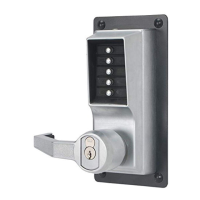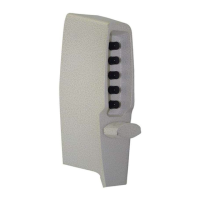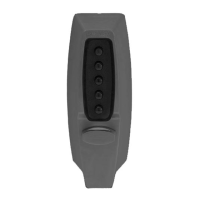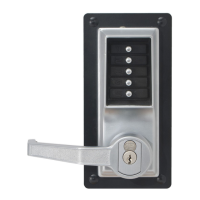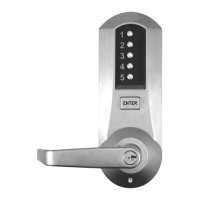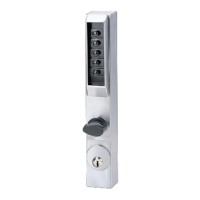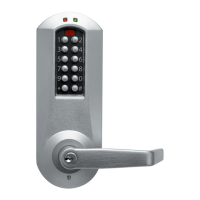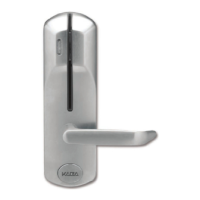056$.$&,@0'(.$&1064$
;@A.996;4A52@A?682
1. Mark the location of the strike on the
door frame (A) according to the tem-
plate. Make certain that the line through
the screw holes of the strike is aligned
with the line through the screw holes on
the face of the latch when the door is
closed (see figure 14-1).
2. Mortise the door frame (for strike box) to
a minimum depth of
3
⁄4" (19 mm). This
will guarantee that the latch (D) can be
fully extended into the door frame when
using a
3
⁄4" throw latch. (The supplied
KABA ILCO strike box must be used).
3. Place the strike box (B) in the mortised
cutout. Secure the strike plate (C) with
two of the
3
⁄4" (19 mm) screws (E)
provided (item “j” on checklist). If
necessary, draw a line around the strike.
Use this line as a guide to cut out a
minimum of
1
⁄1
6
" (2 mm) of material or
enough to make the strike plate flush
with the door frame.
.BA6<; Check the operation of the latch
by making sure that the dead latch stops
against the strike plate, and does not slip
into the strike opening when the door is
closed (A) (see figure 14-2). If this situation
occurs, then a total lockout may result. This
will void our warranty of the complete lock
mechanism.
#<A2 If there is a gap between the edge of
door and the frame (or in the case of dou-
ble doors, the edge of the door and the
edge of the door) of more than
1
⁄4" (6 mm)
the dead latch will fail to engage the strike
plate.
If necessary, correct the door over-travel by
using the rubber bumpers as described in
“Preserving the latch”.
1. Marque en el marco de la puerta el lugar
donde va la contra (A), siguiendo las indi-
caciones de la plantilla. Asegúrese que la
línea que atraviesa los agujeros de los
tornillos de la contra está alineada con la
línea que atraviesa los agujeros de los
tornillos de la chapa del pestillo, cuando
la puerta está cerrada (véase la ilus-
tración 14-1).
2. Corte el marco de puerta (para empotrar
la caja guardapolvo) hasta una profundi-
dad mínima de
3
⁄4 pulg. (19 mm). Esto
garantizará que el pestillo (D) entre
completamente en el marco de la puer-
ta. (Deberá utilizarse la caja guardapol-
vo suministrada por KABA ILCO).
3. Coloque la caja guardapolvo (B) en el
corte que ha hecho para empotrarla. Fije
la contra (C) con dos de los tornillos de
3
⁄4 pulg. (19 mm) provistos (artículo “j” en
la hoja de verificación). Si es necesario,
dibuje el contorno de la contra. Use esta
línea como guía para cortar un mínimo
de
1
⁄16 pulg. (2 mm) de material o lo
suficiente para que la contra quede al
ras con el marco de la puerta.
4(&$7&,@0 verifique, al quedar la
puerta cerrada, el funcionamiento del
pestillo asegurándose que el pin de seguri-
dad del mismo quede detenido por la placa
de contra y no entre en la abertura de la
misma (A) (véase la ilustración 14-2). Si
esto se produce, es posible que la puerta
se cierre completamente y no pueda
abrirse. En ese caso la garantía de todo el
mecanismo de la cerradura quedará anula-
da.
16$ si hay un espacio de más de
1
⁄4 pulg.
(6 mm) entre el borde y el marco de la
puerta (o en el caso de puertas dobles, el
borde de una puerta y el borde de la otra)
el pin de seguridad no logrará enganchar
el batiente donde va la contra.
Si es necesario, corrija el exceso de
batiente de la puerta mediante topes de
caucho, tal como se describe en
“Mantenimiento del pestillo”.
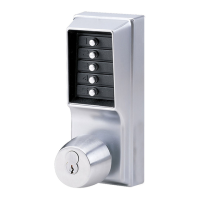
